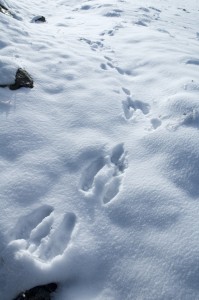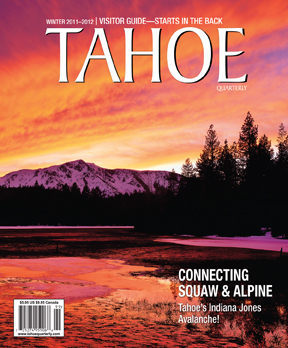Natural Rhythms: Winter
Animals have three basic strategies for coping with Tahoe winters: leave the region, stay active and struggle to find food and stay warm, or shut down. Some animals combine strategies, and black bears are a great example. In colder parts of North America, bears retreat to a den and become inactive, but few bears do this in warm climates. At Tahoe, the situation is complex: Most bears (especially females) become winter-dormant, though we do see active bruins mid-winter. Studies from the southern Sierra Nevada suggest availability of food is the best overall predictor of winter-dormancy. Unfortunately, garbage often proves to be a fairly reliable food source. In the spring, late-season storms can delay the availability of natural food, driving many bears downhill or into neighborhoods in search of sustenance.
Shrews and moles are small rodent-like mammals that primarily eat invertebrates, yet remain active throughout the winter. Our broad-footed mole tends to stay just below the surface, and is little affected by the snow. In fact, added moisture can soften the soil surface, making for easier burrowing. But Tahoe’s four species of shrew face a serious energetic challenge. Even during the bonanza of summer, the tiny shrews have such high metabolisms that they must eat every few hours to stay alive. How they find enough prey to sustain themselves through a long Tahoe winter is something of a mystery, but enough survive that, come summer, shrews become some of the most numerous mammals across many of Tahoe’s ecosystems.
Fresh tracks
While a few species spend all winter beneath the snow, many others travel over its surface. Snow is the blank page upon which winter-active animals write their diary entries. The trick to reading these stories is learning the language: size, shape, gait, pattern, context. Tracking is the science and art of interpreting animal signs, especially footprints. An expert can infer remarkable amounts of information from the subtlest of clues, but anyone can enjoy the aesthetics of tracking.
Snow tracking is best after a long stretch of cold, calm weather, when many animals will have traveled across the latest snowfall, but with minimal distortion to the tracks themselves. “Dust on crust” snow can be optimal for detail. Bring a book (Mammal Tracks & Sign by Mark Elbroch is fantastic, but expensive; illustrations can be found in basic mammal field guides), warm clothes and a camera or sketchpad. A small tape measure and ruler can be helpful. Creeks are always a good place to look, but prints are likely to be found in any forest clearing. Commonly encountered tracks include weasels, snowshoe hares, tree squirrels and even mice.
Tree wells
Vegetation and terrain features create variability in the depth and density of the snowpack across the region. One phenomenon in particular is worth paying attention to—tree wells. Tree wells are hollows or areas of loose snow adjacent the trunks of trees that are surrounded by deep snow, and they can trap unsuspecting skiers or snowboarders. These hollows are formed by a combination of causes: Most importantly, the conical shape of fir trees sheds snow away from the trunk, while lower branches form a canopy. Second, these trees comprise living tissue; the heat generated as a byproduct of their metabolism melts away snow from the trunk. Third, sun hitting the dark trees can warm the snow immediately surrounding the trunk. Add a blanket of heavy snowfall to conceal the hollow and form a trapdoor and you have the makings of a potentially dangerous tree well. By Will Richardson. TQ
Category: Natural World, Outdoors, Winter







